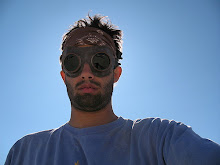How far will a snowball go when thrown from a trebuchet? In all likely hood, you, dear read, have neither the answer to this question, nor any particular interest in knowing it. But if you can believe it, the desire to know the answer to said question drove seven of my friends and I out to the park on a cold winter's day. Armored with coats and sleds we dredged out to the far reaches of Cambridge's own Danehy Park, ready to brave the elements for the promise scientific enlightenment and certain victory.
What force would drive a man to leave the comfort of his home on a mild winter's day merely for such trivia? Madness you may say. Sadly no. As is the case with everything else on my blog, a friend of mine made an off-handed suggestion and I'm impulsive and easily excited. That friend, Dr. Lisa Flanagan, founder of Flanagan Laboratories (LLC) developed and patented a revolutionary new technology for tracking snowballs in the snow.
Finding a snowball in the snow, since it is itself snow, seems an intractable problem at first blush. The impossibility, though never formally proven with any satisfying rigor, was the dominant opinion in the field until Flanagan's work. The details of the method remain a trade secret, and many skeptics have accused Flanagan of fudging her numbers, but as time goes on, the possibility of accurate snowball tracking increases in popular acceptance.
I submit to you the results from the first field test in video form for easy consumption. The video is provided with subtitles for Haze, who is deaf. In fact, you know what? This video is dedicated to Haze, who took a snowball to the head so that we could all laugh just a little bit harder.
Monday, March 2, 2009
Subscribe to:
Posts (Atom)
